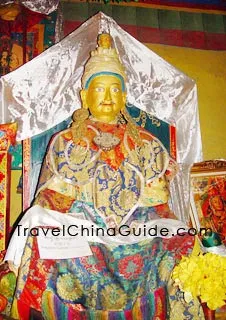Songtsen Gampo
 |
| Songtsen Gampo |
Greatly influenced by his father, Songtsen Gampo has shown the singular gift since childhood. At the age of thirteen, he acceded to the throne after his father was poisoned. He established Tubo slavery regime and moved the capital to Luosuo (today's Lhasa) after he quelled the rebellions from all parts of the region. Because of his efforts, Tibet was finally unified. By making laws, regulations and tax systems, and by fostering the development of farming and stockbreeding, Tibet prospered.
At the time he took the throne, the people living here did not have a writing system and kept records by tying knots. To address this, Songtsen Gampo sent sixteen nobles including the minister Thonmi Sambhota to India to study Sanskrit and writing. They created a spoken and written language, and translated the Buddhist doctrines into this new language. This contribution helped to preserve, transmit and develop the Tibetan culture.
Admired by the prosperity of the Tang Dynasty, Songtsen Gampo sent an envoy to the Emperor Tang Taizhong. In 639, after he married Princess Chizun of Nepal, he proposed a marriage to the Tang Dynasty. In 641, the Emperor Tang Taizong sent Princess Wencheng to marry him. Princess Wencheng brought with her a wide array of advanced cultural and technological ideas, which further promoted the economic and cultural development on the land.
In 650, Songtsan Gampo died of an illness. Emperor Tang Gaozong, the son of the Emperor Tang Taizong, bestowed upon him the honorary title of "The King of Xihai Jun". A stone statue of him was placed next to Zhao Ling, the Mausoleum of the Emperor Tang Taizong. This high honor commemorates the friendly relationship between the Tang and Tubo Empires.
 |
| Songtsen Gampo was buried in Yumbu Lakang |
Today, in many temples there, the statues of Songtsan Gampo enjoy an equal position to those of Sakyamuni and the Master Zongkapa. In every Tibetan family, he is the first to be worshipped. His statues are easily recognized – this is because when the locals make his statue, they add a smaller head over his head to show their respect to the king's great wisdom. In the Ramoche Monastery, visitors may find a statue of Songtsan Gampo with two heads, winning eternal celebrity in the hearts of local people.
Related Link: Tibet History
- Last updated on Aug. 15, 2025 by Demi Li -